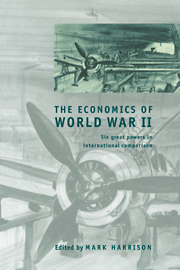Book contents
- Frontmatter
- Contents
- List of figures
- List of tables
- List of contributors
- Preface
- List of abbreviations
- 1 The economics of World War II: an overview
- 2 The United Kingdom: ‘Victory at all costs’
- 3 The United States: from ploughshares to swords
- 4 Germany: guns, butter, and economic miracles
- 5 Italy: how to lose the war and win the peace
- 6 Japan: guns before rice
- 7 The Soviet Union: the defeated victor
- Index
4 - Germany: guns, butter, and economic miracles
Published online by Cambridge University Press: 12 September 2009
- Frontmatter
- Contents
- List of figures
- List of tables
- List of contributors
- Preface
- List of abbreviations
- 1 The economics of World War II: an overview
- 2 The United Kingdom: ‘Victory at all costs’
- 3 The United States: from ploughshares to swords
- 4 Germany: guns, butter, and economic miracles
- 5 Italy: how to lose the war and win the peace
- 6 Japan: guns before rice
- 7 The Soviet Union: the defeated victor
- Index
Summary
Introduction
Research into German rearmament and the war economy began even before the Third Reich had been completely destroyed. In March 1945, when Anglo-American troops had just begun to occupy the Ruhr, the US Air Force started to take stock. It assembled a group of economic experts to assess the effects of the strategic bombing campaign on the German war economy. The ostensible main purpose was to establish which lessons could be learned from the German experience for the continuing war in the Far East. In fact, already at this stage, the US air force wanted to document its contribution to the Allied victory. Led by John K. Galbraith (later of Harvard University), a team of young experts gathered in Bad Nauheim, whose names read like extracts from ‘a roster of the famous of the next economic generation’. Among them were Burton H. Klein (California Institute of Technology), Nicholas Kaldor (King's College, Cambridge), E. F. Schumacher, Paul A. Baran (Stanford University), Edward Denison (Brookings Institute) and Jurgen Kuczynski (Academy of Sciences, East Berlin). The group had access to the transferred records of the Reich Statistics Office, whose ‘Prompt statistical reports on war production’ documented to the end the efforts of German industry to keep up with the demands of war. A suitable interpreter was found in the head of the Institute for Trade Cycle Research's Industry Department, Rolf Wagenführ, who had prepared these statistics for Albert Speer's planning office.
- Type
- Chapter
- Information
- The Economics of World War IISix Great Powers in International Comparison, pp. 122 - 176Publisher: Cambridge University PressPrint publication year: 1998
- 28
- Cited by



